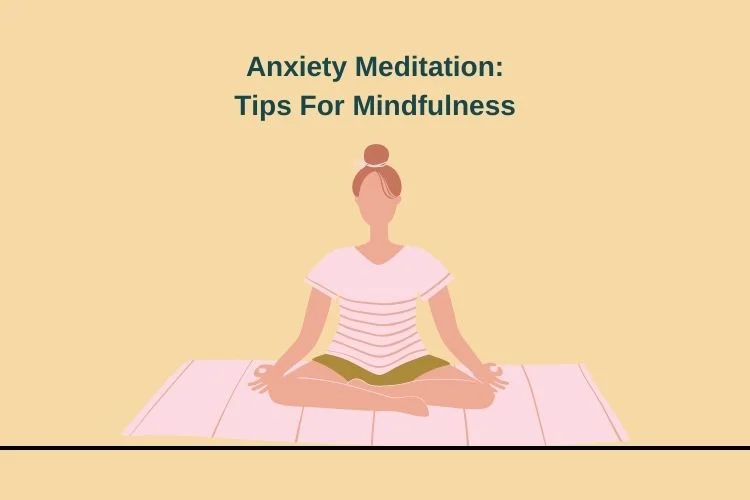चिंता और तनाव कम करने के लिए ध्यान है जरूरी

भागदौड़ भरे जीवन में चिंता और तनाव हमारे दैनिक जीवन का हिस्सा बन चुका है। इसके कई कारण हैं और हमें पता भी होता है कि आखिर चिंता कैसे महसूस होती है। इसके बावजूद उचित प्रबंधन की कमी के कारण हम यह समझ नहीं पाते हैं कि इसे कैसे दूर करें। इसकी जानकारी के आभाव के कारण हम इसमें घिरते जा रहे हैं। हालांकि आपको यह जानना चाहिए कि चिंता की स्थिति में अगर आप ध्यान यानी मेडिटेशन करते हैं तो इस ध्यान से चिंता कम करने में मदद मिलती है। इसके आपको मानसिक शांति का भी अहसास होता है। शायद आपने माइंडफुलनेस मेडिटेशन और इससे चिंता को दूर करने में कैसे मदद मिलती है, के बारे में सुना भी होगा। आज हम इसी पर चर्चा कर रहे हैं। अगर आप चिंता और तनाव दूर करने के तरीके जानना चाहते हैं तो आप सही जगह पर हैं। यहां हम आपको चिंता दूर करने के लिए ध्यान (Meditation for Anxiety) की जानकारी दे रहे हैं। इस ध्यान के जरिए आप अपनी चिंता को दूर कर सकते हैं।
Table of Content
ध्यान से पहले चिंता को समझें
तनाव, डर, असहजता, मुश्किल परिस्थिति या किसी नई स्थिति में हमारे शरीर एक प्रतिक्रिया व्यक्त करता है और यही चिंता है। चिंता हमारी दिमागी जंग है। मन में अनावश्यक खयाल आते हैं और हमारा दिमाग अलर्ट मोड में आ जाता है। रोजमर्रा की लाइफ में भी हमें घबराहट और चिंता महसूस होती है। इसे इस तरह समझ सकते हैं, मान लें की आपकी फेवरेट टीम मैदान में है, तो उसकी हार या जीत को लेकर चिंता होगी या फिर आपको पब्लिकली कहीं कुछ बोलना हो तो उस वक्त भी तनाव की स्थिति उत्पन्न हो सकती है और यही चिंता है। ऐसे चिंता से कोई ज्यादा नुकसान नहीं होता, लेकिन दीर्घकालिक रुप में इसके परिणाम विपरीत हो सकते हैं। अगर आपके मन में बैठा डर या चिंता दूर नहीं होती है तो यह आपके दिमाग में घर कर जाती है और लंबे समय तक आप तनाव की स्थिति रहते हैं। कई बार आप चिंता के कारण अंदर ही अंदर घुटते रहते हैं और यह एक खतरनाक स्थिति हो सकती है। इसे सामान्य चिंता विकार (generalized anxiety disorder, जीएडी) कहा जाता है। इतना ही नहीं इससे आपका समय औऱ ऊर्जा भी नष्ट होता है, कई बार आपके लिए परेशानी का सबब भी बन सकता है।
यहां आपको यह जानना जरूरी है कि तनाव इसका मुख्य कारण है और यह चिंता पैदा करता है। यह पैनिक अटैक जैसी शारीरिक समस्याएं भी पैदा करता है। सामान्य चिंता विकार (जीएडी) किसी व्यक्ति में लगातार बना रहता है और लंबे समय तक उसके साथ रहता है।
हालांकि जब लोग अपनी चेतना और तर्क शक्ति खो देते हैं, तब यह एक विकार बन सकता है। इस स्थिति में आप अत्यधिक चिंता की स्थिति में रह सकते हैं। ऐसे लोग अकारण चिंता करेंगे और हर स्थिति में सबसे बुरे की ही उम्मीद करेंगे।
इसके अलावा, चिंता विकार के कई अन्य प्रकार भी हैं, जिनके बारे में आपको पता होना चाहिए।
- सामान्य चिंता: रोजमर्रा की जिंदगी, बेचैनी और एकाग्रता की कमी को लेकर लगातार चिंता करना। यह किसी भी उम्र में हो सकता है और आपके रोजमर्रा के जीवन और गतिविधियों में हस्तक्षेप करता है।
- सामाजिक चिंता: तर्कहीन चिंता का एक और रूप, यह आत्म-चेतना और शर्मिंदगी पैदा करेगा। इसमें निर्णय, अपमान, या किसी को अपमानित करने की चिंता सताती रहती है।
- पैनिक डिसऑर्डर: पैनिक डिसऑर्डर तब होता है जब लगातार पैनिक अटैक के अनुभव होते हैं। पैनिक अटैक तब होता है जब भय और चिंता की भावनाएं या आसन्न खतरे की भावना होती है।
- अनियंत्रित जुनूनी विकार (Obsessive Compulsive Disorder): आमतौर पर इसे ओसीडी (Obsessive Compulsive Disorder) के रूप में जाना जाता है। यह अनुचित विचार और भय की स्थिति है जो आपको एक अनियंत्रित व्यवहार करने की स्थिति में ले जाता है। हालांकि वे अनचाहे विचार हैं, जिसकी गिरफ्त में आप हैं और आपको इन पर कार्रवाई करने की जरूरत होती है।
ध्यान या मेडिटेशन के दीर्घकालिक लाभों की बात करें तो इनमें से एक यह है कि यह आपको चिंता प्रबंधन में मदद कर सकता है। इसके बारे में हम यहां बता रहे हैं कि यह कैसे होता है।
चिंता मेडिटेशन और माइंडफुलनेस (mindfulness)
माइंडफुलनेस, जैसा कि नाम से ही पता चलता है, कि यह वह स्थिति है जिसमें पता चलता है कि आप अपने दिमाग से पूरी तरह अवगत हैं। आपके आसपास क्या हो रहा है, आप क्या कर रहे हैं, आपके दिमाग में गुजर रहे विचार के अलावा सब कुछ की आपको जानकारी होती है। माइंडफुलनेस (mindfulness) की बात करें तो यह चिंता करने या अपने विचारों से अभिभूत हुए बिना पल भर में प्रस्तुत होने की आपकी क्षमता है। ऐसे में ध्यान, माइंडफुलनेस प्राप्त करने के सर्वोत्तम तरीकों में से एक है। दीर्घकालिक तौर पर यह आपके तनाव और चिंता को प्रबंधित करने में मदद करता है।
माइंडफुलनेस से आत्म-जागरूकता आती है। जब आप सेल्फ अवेयर होते हैं, तो आप अपने लिए उन संसाधनों की खोज कर रहे होते हैं, जिन्हें आप नहीं जानते थे। यहां स्थिति को बदलने से ज्यादा इस बात को समझना महत्वपूर्ण है कि आप इस चिंताजनक स्थिति का सामना कैसे करते हैं और कैसे यह आपकी मदद करता है।
माना जाता है कि माइंडफुलनेस से आपके मानसिक स्वास्थ्य में सुधार होता है, साथ ही बेकार के तनाव और चिंता से छुटकारा मिलता है। आपके विचारों की जागरूकता और स्वीकार्यता आपको चीजों को सरल रखने के ही साथ चिंता को प्रबंधित करने में मदद करती है।
यहां हम चिंता को लेकर ज्यादा गहराई में जाने की बजाय इस पर विचार करते हैं कि इस पर काबू कैसे पाया जा सकता है। ऐसे में यहां हम कुछ तकनीक की जानकारी दे रहे हैं, जिससे आपको चिंता से निजात पाने में मदद मिलेगी।
आप अपने जीवन में कल्याण को कैसे लागू करते हैं? सही गाइड पाने के लिए हमारे ऑनलाइन थेरेपिस्ट से सलाह लें।
चिंता के लिए सरल निर्देशित ध्यान
यहां चिंता दूर करने के लिए कुछ सरल मेडिटेशन तकनीक की जानकारी दी गई है, जिन्हें आप आजमा सकते हैं।
चिंता के लिए ध्यान: तकनीक # 1
ज्यादा तकनीकी बातों में जाने की बजाय, यहां हम समझेंगे कि चिंता से कैसे निपटें।
स्टेप 1: इसकी शुरुआत अपनी चिंता की भावना को बाहर निकलने की अनुमति देने और उन्हें बिना किसी कार्रवाई के स्वीकार करने के साथ होती है। यह आपको अपनी भावनाओं को गहराई तक जमे बिना उन्हें महसूस करने में मदद करेगा। यह उन भावनाओं को पंजीकृत करने की एक प्रक्रिया है, जिसको आप महसूस करते हैं। आप न तो उससे जूझते हैं और न ही उसके सामने आत्मसमर्पण करते हैं, बल्कि उनके अस्तित्व को स्वीकार करने की कोशिश कर रहे हैं।
स्टेप 2: अपने नकारात्मक विचारों को नकारना महत्वपूर्ण है। जैसा कि ऊपर दिए गए चरण में बताया गया है, इसे अस्तित्व में बनाए रखने से मदद मिलेगी। अपनी भावनाओं या नकारात्मक विचारों को जमे न रहने दें, क्योंकि यह आपकी मानसिक शांति को आपकी सोच से भी ज्यादा नुकसान पहुंचा सकता है।
इससे घबराने की बजाय सकारात्मक सोच से काफी मदद मिलेगी। यहां यह सोचने की बजाय कि मैं इसका सामना करने में सक्षम नहीं हूं, की बजाए यही डर है और यही कारण है कि मैं डर रहा हूं के बारे में सोचना चाहिए। यहां आपका लक्ष्य डरना या आत्मसमर्पण करना नहीं बल्कि अपनी भावनाओं को स्वीकार करना है।
स्टेप 3: बात जब चिंता के लिए मेडिटेशन करने की हो तो इसे स्वीकार करना महत्वपूर्ण है। यह हमेशा खुद पर ज्यादा सख्त होने की बजाय अपनी भावनाओं को स्वीकार करने में मदद करेगा। इसके लिए काम और अभ्यास की आवश्यकता होती है और इस वक्त मेडिटेशन से मदद मिल सकती है। सेल्फ अवेयर होने से आप कुछ अप्रिय मूवमेंट्स को महसूस करना और इससे पार पाना सीख सकते हैं। सरल शब्दों में कहा जाए तो, ध्यान इस बात की समझ देता है कि अप्रिय अनुभवों से गुजरना ठीक है।
चिंता के लिए ध्यान: तकनीक # 2
यह 30 मिनट के ध्यान के समान है, हालांकि, यह तनाव और चिंता को कम करने के इरादे से किया जाता है।
स्टेप 1: यह खुद के प्रति आभारी होने का समय है। इस समय खुद को प्रस्तुत करें। हालांकि इसमें थोड़ा समय भी लग सकता है।
स्टेप 2: इस बात का अहसास करें कि आपको मन में क्या महसूस हो रहा है और अपने शरीर के साथ जुड़ें। क्या आपकी मांसपेशियों में कोई तनाव है? क्या आपको कोई संवेदना महसूस हो रही है? आपका मूड कैसा है? सभी चीजों को एक्सेप्ट करें और इन्हें बने रहने दें।
स्टेप 3: अब, धीरे-धीरे अपना ध्यान अपनी श्वास पर स्थानांतरित करें। सांस लें और सांस छोड़ें। अपने शरीर में आने और जाने वाली हवा को महसूस करें। यहां सबसे महत्वपूर्ण बात यह है कि इन सभी से अवगत रहें।
स्टेप 4: जब भी आपको लगे कि आप तैयार हैं, तो अपना ध्यान सांस से हटाकर शरीर पर लगा दें। शरीर पर ध्यान देने का मतलब और कुछ नहीं बल्कि इसमें उत्पन्न होने वाली संवेदनाओं को महसूस करना है। यहां एक बार फिर से विचार और भावनाएं होंगी। बस उन्हें स्वीकार करें और उन्हें बने रहने दें।
स्टेप 5: यदि आप अपनी मांसपेशियों या पीठ में कोई तनाव महसूस करते हैं, तो इसे नरम करने का प्रयास करें। बेचैनी को खुद पर हावी न होने दें। आप शरीर से सांस लेने की कल्पना कर सकते हैं, जैसे कि ऊर्जा की लहर आपके पैरों से लेकर सिर तक प्रवाहित हो रही हो। इस पर गौर करें साथ ही पूरी प्रक्रिया पर ध्यान बनाए रखें।
स्टेप 6: अब यदि आपके मन में किसी तरह के चिंताजनक विचार उत्पन्न होते हैं, तो इससे आपको नुकसान हो सकता है, इसलिए खुद के साथ अन्याय न करें। ध्यान करते समय भी मन में कुछ चिंताओं और आशंकाओं का अनुभव हो सकता है। खासकर जब आप चिंता के लिए ध्यान कर रहे हों, तो ये विचार आपके पास आएंगे ही आएंगे। हालांकि ये एक अंतर्निहित भय भी हो सकता है जिससे आप अनजान हैं। ऐसे में खुद पर और विचारों पर ध्यान दें और जो महसूस कर रहे हैं उसे स्वीकार करें। आपका लक्ष्य उन आशंकाओं और चिंताओं पर प्रतिक्रिया देना नहीं बल्कि इसके बारे में ज्यादा से ज्यादा जानना या समझना है कि हम उनके बारे में क्या महसूस करते हैं।
स्टेप 7: अपने भय को स्टेप बाय स्टेप समझें। हालांकि एक बात जान लें कि यदि आप किसी भी तरह से असहज हैं तो आगे न बढ़ें। यह धीरे-धीरे चिंता की गिरफ्त में आने और इसके अंतर्निहित कारणों को समझने की एक प्रक्रिया है। यहां इस बात को समझें कि जब भी भावनाएं उठती हैं, तो उन्हें स्वीकार करें और आगे बढ़ें। आखिर जानना ही हमारा लक्ष्य है।
स्टेप 8: एक बार जब आप अपनी भावनाओं पर नियंत्रण पा लेते हैं और उन्हें स्वीकार कर लेते हैं, तो धीरे से उस स्थान से हट जाएं। यह वही समय है जब आपको श्वास प्रक्रिया पर वापस लौटना होगा यानी वर्तमान स्थिति में आ जाएं। अंदर और बाहर सांस लें। यहां केवल आपको जागरूक होने की जरूरत है।
स्टेप 9: यह स्टेप काफी महत्वपूर्ण है। यहां आपाको आती और जाती सांसों को साथ अपने विचारों पर नजर बनाए रखने की जरूरत है। अपने विचारों को कुछ इस तरह देखें, जैसे वे आपके दिमाग में एक फिल्म की तरह खेल रहे हैं। अपने विचारों और वे कैसे बदलते हैं, इसपर ध्यान दें। यह भी देखें कि आपका दिमाग उनसे कैसे निपटता है। हम अपने विचारों से जितना ज्यादा अवगत होंगे, उतना ही अधिक उन्हें मुक्त कर सकते हैं। आप अपने विचारों को जितना ज्यादा मुक्त करेंगे, आपकी मानसिक स्वतंत्रता उतनी बेहतर होगी।
स्टेप 10: जैसे-जैसे हम करीब जाते हैं, वैसे-वैसे अपनी सांसों पर वापस आने का समय आता है। जो लोग चिंताओं से घिरे हैं वे इस समय का उपयोग ब्रह्मांड के लिए अपनी इच्छाओं को बढ़ाने के लिए करें। जिस तरह आप अपनी चिंता पर काबू पाने का प्रयास कर रहे हैं दूसरों को भी इसके लिए शुभकामनाएं दें। आप अपनी चिंता को दूर करने की दिशा में प्रयास कर रहे हैं, इसके लिए खुद के प्रति आभार प्रकट करें।
स्वास्थ्य आपके जीवन के लिए क्यों महत्वपूर्ण है? हमारे ऑनलाइन मानसिक परामर्शदाताओं से मार्गदर्शन लें।
चिंता के लिए ध्यान: तकनीक # 3
चिंता दूर करने के लिए सर्वोत्तम ध्यान प्रक्रिया की बात करें तो यहां एक बात समझने वाले है कि इसमें स्टेप का कहीं कोई स्थान नहीं है, क्योंकि यहां आपको समय की जरूरत होती है। स्टेप वाइज हम कैसे क्या कर सकते हैं, इसके बारे में तो हम जान चुके हैं, लेकिन यहां हम 20 मिनट के ध्यान की बात करेंगे। आप भी इसका पालन कर सकते हैं। आइए जानते हैं समय आधारित ध्यान के बारे में
0 से 2 मिनट: यहां दया और करुणा की बात करेंगे, क्योंकि आपके लिए यह जानना महत्वपूर्ण है कि आप ध्यान क्यों कर रहे हैं। हम यहां चिंताजनक भावनाओं के साथ काम करेंगे और इसके मूल में जाने की कोशिश करेंगे।
अगर आप शुरुआत कर रहे हैं तो सबसे पहले बैठें या लेट जाएं। अपनी स्थिति चुनें, क्योंकि जब तक आप सहज हैं, तब तक सब कुछ ठीक है। खुद के भीतर प्रवेश से पहले व्यवस्थित होने का प्रयास करें, क्योंकि यहां हम चिंता के लिए माइंडफुलनेस के क्षेत्र में प्रवेश करने जा रहे हैं। यहां आपको जानने की जरूरत है कि यह मेडिटेशन किसी चीज को ठीक करने, विश्लेषण करने या समाधान करने के लिए नहीं बल्कि अपनी भावनाओं को बनाए रखने के लिए है।
2-8 मिनट : यह समय धीरे-धीरे अपना ध्यान सांसों पर स्थानांतरित करने का है। हवा को अंदर और बाहर जाते हुए महसूस करें। उस जगह पर ध्यान केन्द्रित करें, जहां आपको लगता है कि सांस लेना महत्वपूर्ण है। यह आपकी नाक, पेट, छाती कहीं भी हो सकता है।
याद रखें, यहां ज्यादा कुछ नहीं करना है, केवल सामान्य और प्राकृतिक सांस लेते रहें। यदि आपका मन भटकता है, तो उन जगहों का ध्यान करें जहां यह जा रहा है और फिर वापस आ जाएं। यहां इस बात का ध्यान रखें कि आपका लक्ष्य वर्तमान में बने रहना है। एक वक् तपर एक बार सांस लें और एक बार छोड़ें।
8-12 मिनट: यह ध्यानपूर्ण जांच का समय है। कई लोगों के लिए, यह एक कठिन अनुभव हो सकता है और यहां इस बात को समझना जरूरी है को आपको अपने मस्तिष्क में ज्यादा तनाव नहीं देना है।
यह जानने की कोशिश करें कि चिंता का कारण क्या है। यदि कोई विशिष्ट कारण है, या कोई हालिया अनुभव, जिसके कारण आफ चिंतित महसूस कर रहे हैं, तो उसे याद करने का प्रयास करें। उस वक्त के अनुभव पर ध्यान दें और खुद से पूछें कि कैसा महसूस हुआ।
जो भी विचार, भावनाएं या संवेदनाएं आपके पास आ रही हैं, उन्हें महसूस करें। भले ही वे दु:ख, क्रोध, भ्रम, तनाव या चिंता पैदा करतीं हो, उन्हें बने रहने दें और ध्यान बनाए रखें।
12-16 मिनट: अब यहां अपनी भावनाओं को समझने की जरूरत है। भावनाओं की बात करें तो यादें, हम क्या महसूस करते हैं, अनुभव और उनकी परिभाषाएं मूल रूप से बताती हैं कि हम कौन हैं। उनमें पैटर्न पर गौर करें। आत्म-जागरूकता और समझ से आपको मुक्ति का अहसास होगा। जब भी चिंतित हों, अपनी सांसों को स्थिर करने का प्रयास करें
16-18 मिनट: एक बार फिर से यह समय सांसों पर लौटने का है। हवा को अंदर और बाहर जाते हुए महसूस करें, क्योंकि आप अपना ध्यान वापस अंदर और बाहर निकालने पर लगाते हैं। एक बार फिर से शरीर के किसी अंग पर ध्यान केन्द्रित कर अपने मन और शरीर को व्यवस्थित करें।
18-20 मिनट: यह आत्म-करुणा पर फोकस करने का समय है। ध्यान में आने के लिए आपने जो साहस प्रदर्शित किया है, इसके लिए अपनी पीठ थपथपाएं। यहां उस ज्ञान, ज्ञान और करुणा को महसूस करें जिसे आपने अपने दिल से प्राप्त किया है। अब अपनी आंखें खोलें, अपने माहौल पर वापस लौटें और शांति से रहें!
वैसे तो ध्यान की कई तकनीक हैं, लेकिन मुख्य रुप से उपरोक्त इन तीन का प्रयोग आप ध्यान के लिए कर सकते हैं। इससे आपको अपनी चिंता और तनाव को दूर करने में मदद मिलेगी। इसकी शुरुआत करने से पहले आपको बता देते हैं कि मेडिटेशन संबंधी इन निर्देशों से आपको कैसे मदद मिलेगी।
क्या आप अपनी चिंता से परेशान हैं? क्या आप विशेषज्ञों से बात करना चाहते हैं? सही समाधान के लिए किसी ऑनलाइन मनोवैज्ञानिक से सलाह लें।
ध्यान और चिंता, जानिए कैसे करता है काम
चिंता के लिए माइंडफुलनेस मेडिटेशन आपको कैसे बेहतर तरीके से प्रबंधित करता है, इसके तीन अलग-अलग चरण हैं। यदि आप चिंता को कम करने के लिए कोई मेडिटेशन करते हैं तो यहां आपको पता चल जाएगा कि दीर्घकालिक तौर पर इससे आपको कैसे मदद मिलेगी।
अपनी भावनाओं को स्वीकारें
अपनी भावनाओं को स्वीकार करने से आपको यह समझने में काफी मदद मिल सकती है कि आखिर आप क्यों चिंतित हैं। यदि वे परेशान करने वाले कोई कारण या दर्दनाक यादें हैं, तो उन्हें स्वीकार करें, क्योंकि ऐसा करने से आपको उन्हें खत्म करने के मूल कारणों को प्राप्त करने में मदद मिलती है।
अन्वेषण (analysis)
आखिर आपको तनाव और चिंता क्यों हो रही है, हर बार इसका पता लगाना आसान नहीं होता है। ऐसे में चिंता के लिए ध्यान आपको अपने बारे में अधिक आत्म-अन्वेषण और जागरूकता के साथ अंतर्निहित कारणों की तलाश करने में मदद कर सकता है। ध्यान आपके लिए एक ऐसा वातावरण तैयार करता है, जिससे आपको इस बात का अहसास हो जाता है कि आपकी चिंता का मुख्य कारण क्या है।
मन की शांति
चिंताओं और कारणों का पता लगाने से आपको अपने चारों ओर स्वतंत्रता और बेहतर माहौल की भावना पैदा करने में मदद मिलेगी। यह वह स्थान है, जहां आप स्वाभाविक रूप से जा सकते हैं और खुद को बेहतर समझ सकते हैं। दीर्घकालिक तौर पर बात करें तो यह स्वाभाविक रूप से मानसिक शांति प्रदान करेगा। इस प्रक्रिया को शुरू करने से पहले आपको कुछ बातों पर ध्यान देने की जरूरत है।
विचार करने योग्य बातें
अगर आप चिंता दूर करने के लिए ध्यान शुरू करने जा रहे हैं तो आपको पहले यहां कुछ बातों पर ध्यान देना चाहिए। कई बार आपको ध्यान करना मुश्किल हो सकता है। अगर आप चिंतित या तनावग्रस्त हैं तो ऐसी स्थिति उत्पन्न हो सकती है। ऐसी स्थिति में सामान्य होना आसान बात नहीं है।
इस दौरान आपको यह भी महसूस हो सकता है कि काफी कुछ करना बाकी है और आस-पास बैठकर ध्यान करने से कोई फायदा नहीं होगा। तो, यहां आपके यह समझना होगा कि यह नकारात्मक विचारों को अपने दिमाग में प्रवेश करने से रोकने का समय है, क्योंकि जब आप आराम करने की कोशिश कर रहे होते हैं तो वे आपकी मदद नहीं करेंगे। हालांकि, कुछ तरीके हैं, जिससे आप इन बाधाओं को दूर कर सकते हैं।
ध्यान से चिंता दूर करने के लिए इन्हें भी जानें
1. सही अपेक्षाएं रखें
ध्यान करना आसान नहीं है और जब आप चिंता से जूझ रहें होंगे तब यह और भी कठिन होगा। यहां इस बात का ध्यान रखें कि प्रक्रिया पर ध्यान देने की कोशिश करें न कि परिणाम पर। यहां एक बात जान लें कि पहली बार से ही सकारात्मक परिणाम मिलने की संभावना नहीं है। मेडिटेशन के लिए अभ्यास और अनुशासन चाहिए।
2. शेड्यूल बनाकर बढ़ें आगे
अगर आप काफी व्यस्त हैं और आप सोचते हैं कि आपके पास समय नहीं है, तो भी ध्यान के लिए थोड़ा समय निकालें। आपका जो भी शेड्यूल हो, उसमें सबसे जरूरी की श्रेणी में मेडिटेशन को शामिल करें। आपको हमेशा इसे एक आदत बनाने की कोशिश करनी चाहिए।
ध्यान से दूर होगा तनाव
उम्मीद है कि यह आपकी रोजमर्रा की चिंता को दूर करने और मन की शांति को प्राप्त करने में मदद करेगा। यहां इस बात को ध्यान रखने की जरूरत है कि केवल मेडिटेशन चिंता विकार जैसी स्थितियों को ठीक करने के लिए चिकित्सा का विकल्प नहीं है। यह भी समझने वाली बात है कि मेडिटेशन से कोई चीज जल्द ठीक नहीं होती। यह एक दीर्घकालिक प्रक्रिया है, और नियमित अभ्यास में इसमें फायदा हो सकता है। यदि आप चिंता विकार से जूझ रहे हैं और चिकित्सकीय इलाज चल रहा है, तो आपको विशेषज्ञ या डॉक्टर से बात करने की सलाह दी जाती है। अपने चिकित्सक से सही परामर्श और चर्चा के साथ आप अपने इलाज के साथ ही ध्यान को शामिल कर सकते हैं।
आप घर पर अपने मानसिक स्वास्थ्य को कैसे ठीक कर सकते हैं? अभी ऑनलाइन चिकित्सक से बात करें।













